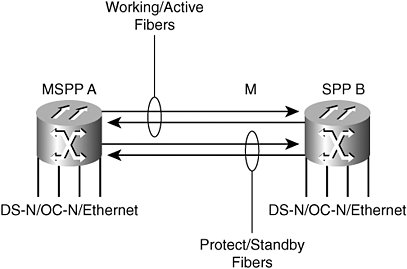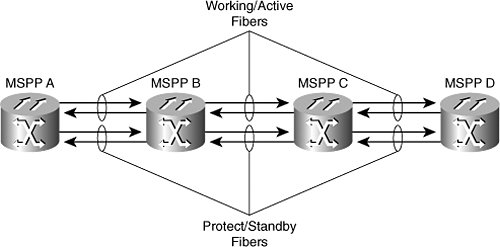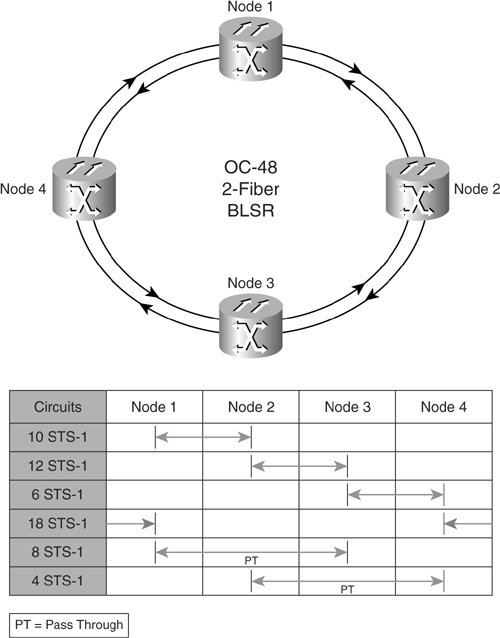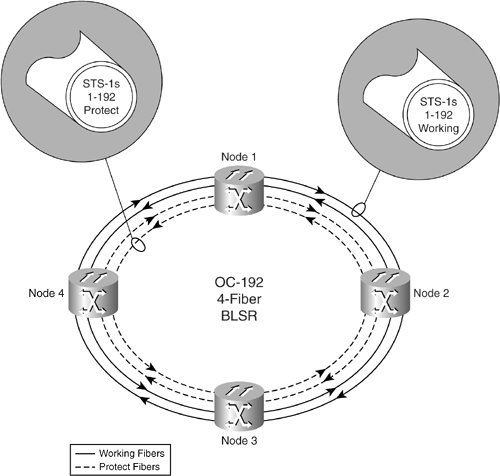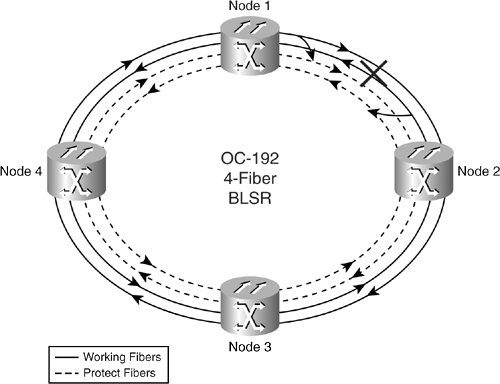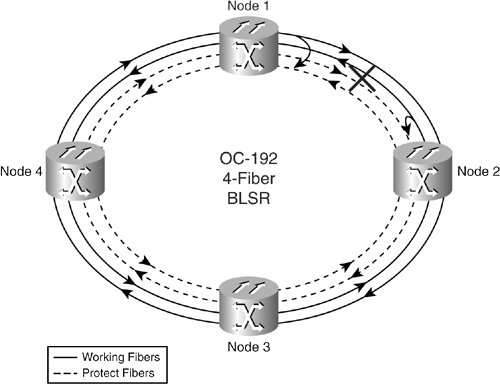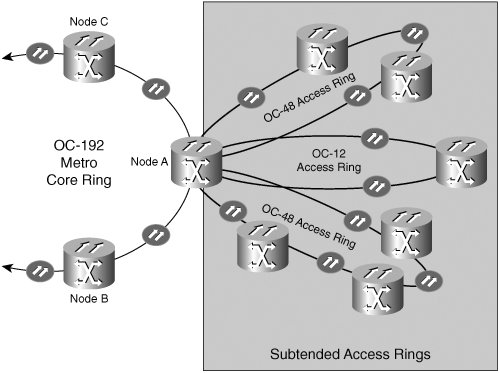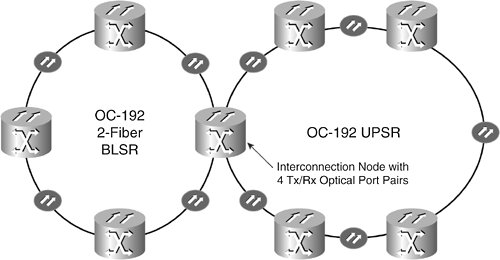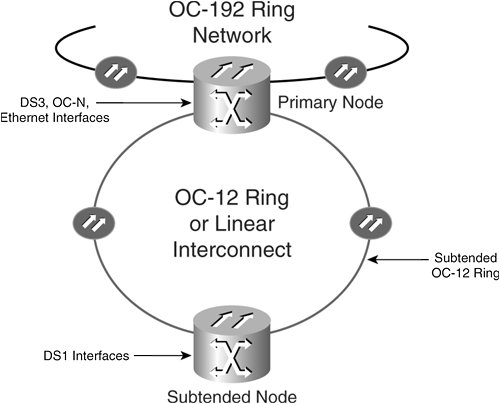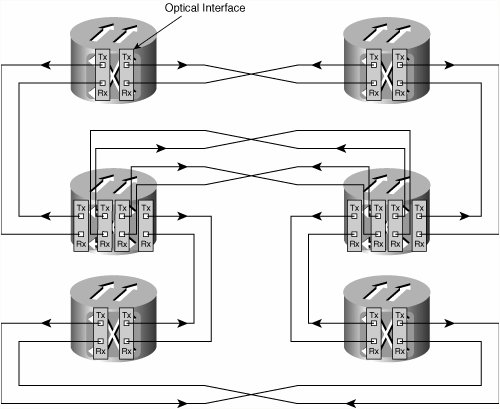MSPP Network Topologies
| Network-protection characteristics and total system payload capacity are determined largely by the type of network topology deployed. SONET MSPPs provide support for multiple available topologies, with varying levels of resiliency and traffic-carrying capabilities. These topologies include linear, ring, and mesh networks. This section covers these topologies and describes their operation and applications. Linear NetworksOne topology option for MSPP network design is the linear network. Linear networks are typically used when all the traffic to be serviced by the network is routed in a point-to-point manner, or point-to-point with intermediate add/drop locations. Linear networks that transport all traffic between two nodes are commonly referred to as point-to-point or terminal mode networks. If some traffic needs to be inserted into the network at intermediate sites, a linear add/drop network, sometimes called a linear add/drop chain, can be used. Figure 5-8 shows an example of a terminal mode MSPP network. All traffic is routed from Node A to Node B. The connection between the nodes can be protected against facility failures, or it can be designed as unprotected if protection is not a requirement or is provided through some other network connection. If the terminal mode network will be unprotected, a single optical interface card, such as an OC-12 or OC-48, should be installed at each node (or terminal) and a single pair of optical fibers should be used to connect between them. In this case, a failure on the fiber cable span or of one of the optical interface cards causes traffic to be interrupted, and information will be lost unless it can be routed between the sites through some alternate connection. Figure 5-8. A Terminal Mode MSPP Network In the protected scenario, two optical interfaces are needed in each terminal. These can be provided either on separate cards or on different ports of the same multiport card. A type of protection known as 1+1 is provided for this type of network. This means that one of the optical ports on each end (and the associated fiber connection) is set up as "working" or "active"; the secondary ports are the "protect" or "standby" ports. If a port failure or fiber facility failure occurs on the working link, the network switches the traffic to the protection link. To decrease the chances of a failure-related service interruption, terminal mode networks can be designed so that the working and protect ports are on different interface cards in each terminal, and the working and protect fiber pairs are physically routed in separate cable sheaths following diverse paths between the two endpoints. In a linear add/drop chain MSPP network, the intermediate nodes each have a connection to their neighboring MSPP nodes, one facing East and the other facing West. Again, these connections can be either 1+1 protected or unprotected. In the protected scenario, the intermediate add/drop nodes require two pairs of optical interfaces, with a pair facing East and a pair facing West. Figure 5-9 shows an example of a linear add/drop chain network. Figure 5-9. A Linear Add-Drop Chain MSPP Network In modern MSPP networks, linear systems are rarely deployed. This is because of the availability of ring-based networks, which are more fault tolerant and often more economical to deploy. In a ring network, a single-node failure causes a service disruption only for traffic that terminates in that particular node. However, in a linear network, a single node failure can disrupt traffic servicing additional network locations. For example, in Figure 5-9, if MSPP C experienced a failure affecting the entire node (such as a power supply failure), traffic routed from MSPP A to MSPP D would be lost because this traffic transited MSPP C. In a ring network, this transit traffic would be rerouted via an alternate path. This network also can be provided with facility protection much more economically in a ring-based architecture. MSPP C would require a total of four costly optical interfaces if it were installed in a protected linear add/drop configuration, with two interfaces for East and two for West. However, a ring network would require only a single interface in each direction. Ring networks are covered in detail in the following sections. UPSR NetworksA UPSR is a SONET protection topology used to maintain service across the optical network in case of a failure condition, such as a fiber span break or optical interface card failure. In a UPSR, traffic between MSPP nodes is safeguarded by carrying duplicate copies of the signals around diverse East and West paths from origin node to destination node, ensuring a swift failover to the opposite path. Because of this method of operation, a UPSR is sometimes referred to as a dual counter-rotating, self-healing ring. UPSR OperationTo understand the operation of a UPSR, consider Figure 5-10, which shows a typical four-node OC-12 UPSR network. In this example, a client signal is being transported across the network from MSPP A to MSPP C. In the case of a bidirectional signal, such as a time-division multiplexing (TDM) circuit (such as a DS3), the signal consists of a transmit side and a receive side at each termination point; however, for clarity, Figure 5-10 shows only one direction. In the transmit direction from A to C, the signal enters MSPP A through a traffic interface card and is internally routed to the node's cross-connect matrix. Within the cross-connect matrix, the signal is bridged, or duplicated, and connected to both the East-facing and West-facing UPSR optical interface cards for transmission across the optical network. The circuit is assigned to travel on the UPSR on STS-1 path number 1, on both the East and West interfaces. At the intermediate MSPP nodes B and D, the signals are passed through. At MSPP C, a selector switch locks to the highest-quality signal from the two available STS-1 paths. Figure 5-10. UPSR Operation If a problem occurs with the selected signal, such as a high bit-error rate, the selector mechanism switches to the back-up path. Figure 5-11 shows the resulting path switch from a facility failure. Figure 5-11. UPSR Path Switch Example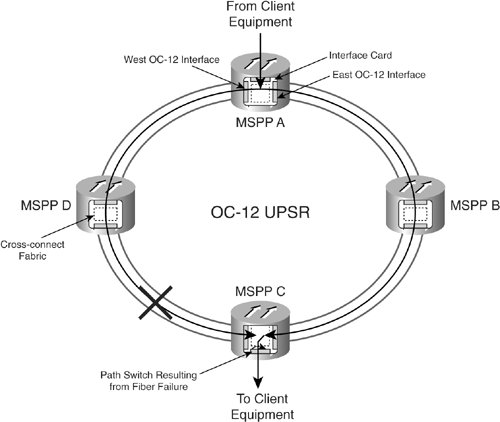 Because each signal transported on the UPSR consumes the same amount of bandwidth on both sides of the ring between the source and destination, the total amount of traffic carried (in Synchronous Transport Signal [STS] equivalents) is limited to the ring's transmission bandwidth, regardless of the origin and destination of the circuits. Therefore, an OC-12 UPSR is limited to transporting 12 total STS-1s, whereas an OC-48 UPSR can handle a total of 48 STS-1s. For example, in the OC-12 network in Figure 5-10, if an STS-3c signal was being carried between MSPP A and MSPP C, and was assigned to use the first three STS-1s (STS-1-1, STS-1-2, and STS-1-3), it would traverse the East path through MSPP B, as well as the West path through MSPP D on these same three STS-1s. This is a major difference between UPSR and bidirectional line switch ring (BLSR) topologies. Depending on the number of nodes in the network and the traffic pattern, a BLSR can accommodate more traffic than the transmission bandwidth. Within the cross-connect matrix of the MSPP, a UPSR-protected circuit consumes three ports on the source and destination nodes, and two ports on the intermediate, "pass-through" nodes. Figure 5-10 shows this. At MSPP A, which is a source/destination node, the DS3 signal is mapped into an STS-1 and enters the cross-connect matrix on a single input/output (I/O) port. Because copies of this signal are to be transported around both the East and West sides of the ring, the signal is sent to two different I/O ports leaving the matrix. One of these will connect to the East optical line interface, the other to the West. Meanwhile, at MSPP B, which is a pass-through node for this circuit, the signal enters one optical interface, gets passed through the matrix by entering one I/O port and exiting another, and then exits through the opposite optical interface. Figure 5-12 shows the details of how this works at each of the circuit-termination nodes. At each of these sites, three STS-1 I/O ports on the cross-connect matrix are consumed for this drop/add circuit. For example, if this were a 60-Gbps cross-connect fabric, with a total of 1,152 STS-1 ports (1,152 x 51.84 Mbps = 59.71968 Gbps), this connection would use 3 of the 1152 ports, or approximately 0.26 percent of its STS-1 capacity. Figure 5-12. MSPP Cross-Connect Matrix Use at a UPSR-Protected Circuit Source or Destination Node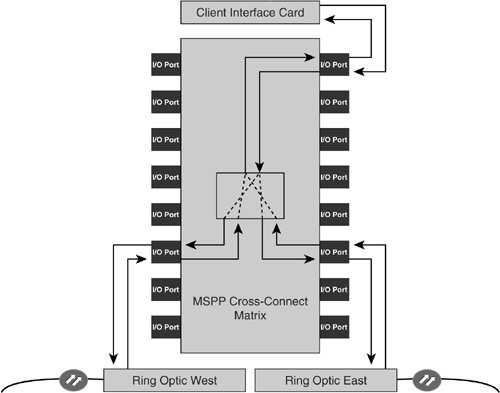 UPSRs can be built using any SONET line rate, including OC-3, OC-12, OC-48, OC-192, and OC-768. In an MSPP configured for UPSR operation, you need two optical interface cards, one designated East and the other designated West. A node design using a multiport optical interface card with separate ports used for East and West would be ill advised because a card-level failure (such as a card power supply failure) would result in losing both ring interfaces. That would cause service disruption on any traffic terminating at that node. SONET MSPPs are typically configured so that an East-designated interface on one node is connected via the fiber-optic network links to the West-designated interface on the next adjacent node, and vice versa. For example, in an ONS 15454 MSPP OC-48 UPSR, a network designer might choose to designate an OC-48 interface card in chassis Slot 5 as the West interface, and an OC-48 interface card in chassis Slot 6 as the East interface. The card in Slot 5 would connect to a similar card in Slot 6 of the adjacent node to the west of this node, and the card in Slot 6 would connect to a similar card in Slot 5 of the adjacent node to the east. Figure 5-13 shows such a design. For simplicity, it is usually recommended that you keep this scheme consistent throughout the network. Figure 5-13. Typical UPSR Fiber Cable Interconnection UPSR ApplicationsUPSRs are best suited for networks in which the traffic requirements call for most circuits to have a single common endpoint, or hub location. Some examples of this type of network requirement include the following:
Figure 5-14 shows one such example. A carrier has deployed an OC-12 ring to service a neighborhood called East Meadow. This MSPP ring needs to service three locations: a residential area, a wireless provider cellular tower, and a business park. Figure 5-14. East Meadow OC-12 UPSR Network The residential area, served by the Fairview Avenue Remote Terminal Cabinet, needs DS1 circuits for connecting a digital loop carrier (DLC) system and a DS3 for the trunk feeder for a remote digital subscriber line access multiplexer (DSLAM). The DLC is used to provide plain old telephone service (POTS) for the neighborhood. The remote DSLAM provides broadband DSL service for high-speed Internet connections. The POTS DS1s is transported back to the Oak Street central office for connection to the PSTN via a Class 5 switch. The DSLAM DS3 must connect to the Asynchronous Transfer Mode (ATM) network equipment at Oak Street. The Highway 21 cellular tower site has a requirement for multiple DS1 circuits. The wireless provider, which purchases this service from the carrier, needs to connect its cell site equipment to its mobile telephone switching office (MTSO). The carrier will connect the DS1s at the Oak Street office to interoffice facilities that route to the MTSO. Customers served by the East Meadow Business Park Site require a variety of services, including primary rate ISDN (PRI) circuits for PBX trunks and 100-Mbps Ethernet links for Internet service provider (ISP) connectivity. These circuits will also need to be routed back to the Oak Street central office to interface with the PSTN or the Internet. Because all traffic for this network needs to be tied back into the Oak Street central office, a UPSR is an excellent choice for the MSPP network topology. BLSR NetworksAs in a UPSR, a BLSR network is designed to allow traffic continuity in case of a fiber span or MSPP node failure. The key differentiator versus UPSR, however, is that the BLSR is not capacity-limited to the transmission bandwidth of the ring. For example, depending on the number of nodes in the network and the traffic distribution, a two-fiber OC-192 BLSR can be used to transport more than 1000 STS-1 equivalents. BLSRs accomplish this via a method called spatial reuse. The same bandwidth, or traffic channels, can be used to transport different signals on different parts of the network. This is shown for both 2-Fiber and 4-Fiber BLSRs in the next sections. 2-Fiber BLSR OperationIn a 2-Fiber BLSR, a pair of optical fibers is used to connect the MSPP nodes on the ring, just as is the case with a UPSR. However, unlike in a UPSR, active traffic is connected through the ring in only one direction from source to destination: either the East route or the West route. In the opposite direction, spare capacity is held in reserve as "protection" bandwidth, in case a failure occurs in the assigned route. This is the case on every fiber link in a 2-Fiber BLSR: Exactly half the SONET bandwidth is used for assigned, working traffic; the other half is held in reserve for protection. Consider the example four-node 2-Fiber OC-192 BLSR shown in Figure 5-15. Each fiber link in the ring, such as the one between Node 1 and Node 2, consists of two fibers transmitting in opposite directions. The bandwidth carried on each fiber is divided equally, with the first sequential half transporting production traffic and the second half reserved for protection. For example, in the link from Node 1 to Node 2 OC-192, the clockwise fiber path can use the first 96 STS-1s to map SONET circuits; STS-1s 97-192 are designated as the protection path for use during a fault-initiated switch. The counterclockwise fiber works in the same manner while transmitting the OC-192 signal in the reverse direction. Figure 5-15. A 2-Fiber BLSR Example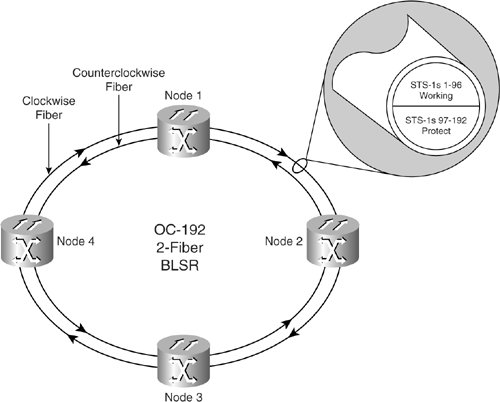 To illustrate the fault-recovery process for a BLSR, reference the scenario shown in Figure 5-16; this is the same network from Figure 5-15, with an STS-3c circuit mapped from Node 1 to Node 3 through the route passing through Node 2 using STS-1s 1 to 3. Figure 5-16. A 2-Fiber BLSR with an STS-3c Circuit-Routed from Node 1 to Node 3 Suppose that a fiber failure occurs on the span between Node 1 and Node 2, with both clockwise and counterclockwise fibers affected as shown. In this case, the traffic would switch as shown in Figure 5-17. The original route for the transmit side (from Node 1 to Node 3) for the signal was rerouted from the clockwise fiber (STS-1s 1 to 3) to the counterclockwise fiber (STS-1s 97 to 99), reaching Node 3 through Node 4. The opposite side of the signal, which is the Node 3toNode 1 transmit direction, traverses the counterclockwise fiber (STS-1s 1 to 3) from Node 3 to Node 2. However, because of the fiber facility failure that has occurred between Node 1 and Node 2, this side of the signal is switched to STS-1s 97 to 99 on the clockwise fiber at Node 2, and reaches Node 1 through Node 3 and Node 4, as shown in the figure. Figure 5-17. A 2-Fiber BLSR Line-Switch Example To facilitate the protection switching in a BLSR, the network elements in the ring use the K1 and K2 bytes in the line overhead to communicate protection-switch requests and status. These bytes are known collectively as the Automatic Protection Switch (APS) bytes. The switching is accomplished by the nodes that are adjacent to the failure (optical line or network node). BLSR operation and protection-switch performance requirements are defined in a Telcordia (formerly BELLCORE) document called GR-1230-CORE. In this document, the total completion time for protection switching and traffic restoration is defined to be less than or equal to 50 ms, not including detection time. This requirement is for networks consisting of a maximum of 16 nodes with up to 1200 km of fiber. 2-Fiber BLSR System CapacityBecause of the protection scheme employed in the 2-Fiber BLSR architecture, the total capacity of a fiber span between two network nodes in this configuration is equal to half the transmission bandwidth, or n/2, where n is the ring's STS-1 capacity (for example: n = 48 in an OC-48 ring, so the capacity of a single OC-48 span is equal to 48/2, or 24). In addition, the protection channel(s) held in reserve on the side of the ring opposite to the assigned working link is defined as c + (n/2), where c is the assigned working STS-1 channel (or first STS-1 in a concatenated signal, such as a STS-12c) and n is the ring STS-1 capacity. For example, in an OC-48 (n = 48) 2-Fiber BLSR, the protection channel for a signal using STS-1 5 (c = 5) would be 5 + (48/2), or 29. Because the total number of STS-1 equivalents that a 2-Fiber BLSR can carry depends on the number of spans, or nodes, in the ring, you need to define an equation for calculating this capacity. The variables in the equation are the number of nodes in the network, the bandwidth, and the traffic pattern for the ring, which is defined in the equation as the number of nonterminated, "pass-through" STS-1s transiting any node in the network. If you use X as the number of nodes, N as the network bandwidth, and A as the number of pass-through STS-1s in the ring, the capacity (or number of circuits that can be carried) for the ring is defined as (N/2) x X A. For each possible 2-Fiber BLSR configuration, Table 5-2 shows the capacity equations.
To illustrate the application of these equations, consider the example in Figure 5-18. This is a representation of a four-node, 2-Fiber, OC-48 BLSR, with the traffic pattern as shown in the accompanying chart. The double-ended arrowed lines in the chart indicate the termination points for the various circuits shown. For example, the first line in the chart indicates that there are 10 STS-1 circuits routed on the ring from Node 1 to Node 2 (directly, with no pass-through nodes); the fifth line in the chart indicates that eight STS-1 circuits are riding the ring from Node 1 to Node 3, passing through Node 2. Figure 5-18. Traffic Routing in a 2-Fiber BLSR Example To calculate the circuit capacity of this ring, you can apply the formula (N/2) x X A, where N = 48 (because the ring is an OC-48), X = 4 (number of nodes), and A = 12. You arrive at the value of A by adding the number of pass-through circuits for each pair of source-destination defined circuit sets. Proceeding through the traffic chart from top to bottom, then, yields 0 + 0 + 0 + 0 + 8 + 4 = 12 total STS-1 pass-through circuits. Substituting these values into the equation, you get a total possible ring capacity, given the current traffic mapping, of (48/2) x 4 12 = 96 12 = 84 STS-1 circuits. Because the ring is currently carrying 58 STS-1s (the summation of all the current services), a network planner can determine that there is space for up to 26 additional STS-1 circuits on this network, depending on their future routing. Protection Channel AccessIn their normal mode of operation, BLSRs inherently have some unused capacity in the form of the traffic channels held in reserve for protection switching. For instance, in an OC-48 2-Fiber BLSR, channels 25 to 48 on all ring spans are normally unused. Most protection-switch events (such as fiber cable cut and human provisioning error) are unplanned and unpredictable; however, it is theoretically possible that a network will operate in a normal, switch-free state for many months, or even years. Because of this, many network operators choose to use the BLSR protection channels to carry live production traffic. In the case of telecom carrier networks, this capability, referred to as protection channel access (PCA), represents an opportunity to generate additional revenue. The caveat to using PCA circuits is that they are typically unprotected, or preemptible. This is because, if a line switch occurs, these PCA circuits will be dropped in favor of the working (protected) traffic. Carriers (which use this arrangement to provide service) typically sell the bandwidth to their customers at a lower rate and offer a more lenient service-level agreement (SLA) to accommodate the possible service interruptions from line switches. This might be a perfectly acceptable arrangement to an end user, who is willing to forgo the reliability of SONET-protected traffic in favor of the economic benefits, or who may not require 99.999 percent network availability. For example, a company that requires a 1-Gbps connection for 4 hours per day for regularly scheduled data backup might be a good candidate for a PCA-based service. The carrier could use a STS-24c or STS-1-21v PCA circuit on an OC-192 BLSR with Fibre Channel interfaces to provide this service to a customer, and still be capable of carrying a normal "full load" of protected traffic. Figure 5-19 shows this application. The STS-24c connection for a Fibre Channel application between Nodes 3 and 4 uses a PCA circuit on STS-1 paths 97 to 120, which is the protection bandwidth for the GigE link between Nodes 1 and 2. Those nodes use STS-1 paths 1 through 24. Of course, STS-1s 1 through 24 can also be used on the other links for carrying traffic because this is a BLSR network. If a line switch occurs on the GigE link, the Fibre Channel circuit is preempted to allow protection for the GigE. Figure 5-19. PCA Use in an OC-192 2-Fiber BLSR for a SAN Extension Application Example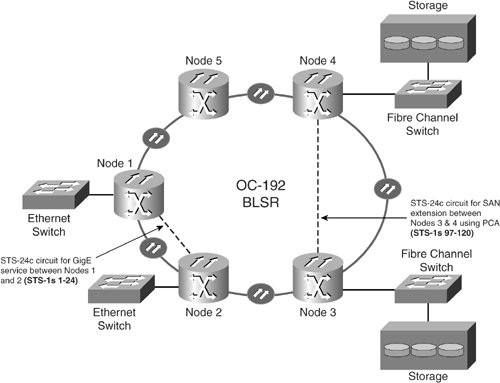 4-Fiber BLSR Operation4-Fiber BLSRs provide twice the available bandwidth of a bandwidth-equivalent 2-Fiber BLSR, but they require additional costs and fiber facility resources to implement. As the name implies, four fiber strands (or two fiber pairs) are required between adjacent network elements in a 4-Fiber BLSR; two fibers are designated as working and two fibers are designated as protect. The entire bandwidth of the working pair can be assigned, whereas all the channels of the protection pair are held in reserve. This is shown in the 4-Fiber OC-192 BLSR in Figure 5-20, in which 192 STS-1 protected channels are available for assignment on the working fiber pair. Figure 5-20. A 4-Fiber BLSR Network Example The 4-Fiber BLSR adds a layer of protection over the 2-Fiber version. In a 4-Fiber BLSR, a facility failure, which affects the working fibers, can be restored using a span switch. Figure 5-21 shows this. If the failure affects the working and protect fibers in the same segment, such as with a fiber cable cut, which severs all four strands, a ring switch occurs, as shown in Figure 5-22. Figure 5-21. A 4-Fiber BLSR Span Switch Example Figure 5-22. A 4-Fiber BLSR Ring Switch Example Although a 4-Fiber BLSR yields twice the bandwidth and offers enhanced protection from facility failures, it requires twice the number of optical fibers and also increases the number of optical interfaces required by a factor of 2. This topology is generally used in high-capacity long-distance carrier networks, such as those owned by U.S. interexchange carriers (IXCs). Typical MSPP implementations of 4-Fiber BLSRs are at the OC-48 and OC-192 levels. 4-Fiber BLSR System CapacitiesThe equation for determining the maximum channel-carrying capability of a 4-Fiber BLSR is similar to the 2-Fiber version, except that the ring bandwidth (N) is not halved in the formula. Table 5-3 shows the equations for performing these calculations, where X is the number of nodes in the 4-Fiber BLSR ring and A is the number of pass-through STS-1 circuits:
BLSR ApplicationsBLSR networks are well suited for distributed, nonhubbed traffic patterns because they can handle traffic requirements that exceed their transmission bandwidth. This characteristic of BLSRs makes it the topology of choice for metro or regional carrier networks in which TDM circuits for PSTN switch trunk links and data circuits for Ethernet or ATM networks are needed among multiple central offices. Subtending RingsIn legacy SONET environments, traffic routing between two or more rings is typically accomplished using low-speed drop connections at digital cross-connect (DSX) panels, or through a separate device called a Digital Crossconnect System (DCS). This is because the older equipment was very limited in terms of ring terminations and cross-connect fabric sizes. With the current MSPP systems in the marketplace, these restrictions no longer apply. In many cases, a single MSPP add-drop multiplexer (ADM) can replace racks of cumbersome DSX panels or expensive DCS gear. This is done by terminating (or "closing") multiple SONET rings on a single MSPP chassis, also known as creating subtending rings. In a large MSPP network, a carrier can use a single MSPP node to aggregate multiple access rings into a single backbone interoffice ring, as shown in Figure 5-23. In this figure, Node A is used to terminate and interconnect several subtended OC-12/48 UPSR access rings into a core OC-192 BLSR for metro or regional transport. These access rings can consist of the same type of MSPP chassis as the core ring, or they can include compatible miniature MSPP systems, which many manufacturers include in their portfolio for the access and customer premise market. For example, the Cisco ONS 153xx series includes several models for both the SONET and SDH markets, which are geared toward OC-3 or OC-12 (and even OC-48) access rings for aggregation of TDM and Ethernet connections. The 153xx series, which includes the 15302, 15305, 15327, and 15310, is compatible with the ONS 15454, which is the Cisco flagship SONET/SDH MSPP. Figure 5-23. An OC-192 Metro Core Ring with Multiple Subtended Rings This MSPP capability can also be leveraged (in some systems) to bridge large backbone rings without costly interconnection solutions, as in the case of two OC-192 BLSRs terminated in a single MSPP chassis (see Figure 5-24). Figure 5-24. Two OC-192 Metro Core Rings Interconnected at a Single MSPP Node Subtending ShelvesBecause of the relatively high cost of high-bandwidth and long-reach optical interfaces (for example, OC-192 long-reach 1550-nm cards are typically some of the most expensive MSPP blades), it is sometimes advantageous to stack or subtend additional shelves from a primary shelf at an MSPP site. For example, if a particular site has a heavy concentration of DS1 interfaces, along with other traffic requirements, it might be more economical to place the DS1 cards in a second shelf and use lower-rate optics, such as OC-3 or OC-12, to interconnect to the primary shelf for routing the DS1s onto the network. Figure 5-25 shows such an arrangement, with a primary node participating in an OC-192 ring with a subtended shelf, interconnected to the primary OC-192 node through OC-12 optical interfaces, used for a high concentration of DS1 drops. This allows the interface slots in the primary shelf to be used for other services, such as DS3, OC-3/12/48, and GigE. Figure 5-25. An OC-192 MSPP Ring Node with a Subtended OC-12 Chassis for DS1 Handoffs Ring-to-Ring Interconnect DiversityOne potential issue with connecting two or more rings at a single site (refer to Figure 5-24) is the creation of a nonredundant point of failurethe interconnection node. If a serious problem, such as a loss of power or natural disaster, occurs at this location, traffic passing between the ring networks through this node will be lost. A method of connecting rings to avoid this issue is known as Dual Ring Interconnect (DRI). In a DRI configuration, rings can be connected at two nodes to eliminate the single point of failure. If these two interconnection points are geographically diverse, such as in different carrier central offices, an even greater level of fault protection is provided. DRI can be achieved with UPSRs, BLSRs, or a combination of the two. DRI can be accomplished in two methods (see Figure 5-26):
Figure 5-28 shows the operation of DRI in a UPSR, in the integrated DRI configuration. Nodes 4 and 5 are the interconnection nodes for the two rings. As shown in the figure, a signal entering Node 1 and bound for Node 8 is bridged in the cross-connect fabric at Node 1. At Node 5, the path selector chooses the primary signal. Using a circuit-creation method known as drop and continue, this signal is also bridged to Node 4 for protection. Similarly, the second copy of the signal bridged at Node 1 is used as the secondary or backup and is dropped to the path selectors at Nodes 4 and 5. This ultimately allows for two copies, a working signal and a protect signal, to be present at the path-selector switch on the receive side at Node 8. This duplication of signals at the interconnect nodes avoids service interruption from the failure of either of these network elements. Figure 5-28. Integrated DRI Configuration Mesh NetworksA mesh network is any set of interconnected locations (for example, MSPP nodes) with at least one loop pathway. Each site in the mesh can be reached from any other site by at least two completely separate routes. Any network other than a point-to-point or purely linear network can be considered a mesh, even a UPSR or BLSR network. However, some of the distinctive features and advantages of a mesh network include these:
Figure 5-29 shows an example of a mesh network. The interconnecting fiber spans can contain a variety of SONET (OC-N) line rates and DWDM links. Figure 5-29. A Mesh Network Cisco provides a supported mesh networking topology on the ONS 15454 MSPP known as a path-protected mesh network (PPMN). Coupled with the automatic circuit-routing feature of the 15454, PPMN provides an effective and efficient means of rapidly provisioning protected traffic across complex meshed networks. Each working and protection path pair effectively forms a virtual UPSR for the circuit. Figure 5-30 shows an example of this. Figure 5-30. Protected Circuit Routing in a Mesh Network Example In this case, a protected circuit is specified to connect Nodes 1 and 10. The network software determines the shortest path between those nodes and routes the circuit accordingly, automatically creating the pass-through cross-connections at Nodes 5 and 6. Traffic between the terminating nodes initially traverses this link. The optimal protection path is calculated to be through Nodes 2, 3, 7, and 11, and pass-through cross-connections are created at those locations as well. If the primary link into Node 10 fails, the MSPP performs a protection switch and selects traffic on the protection link from Node 11 instead of the primary link from Node 6. Note that the loop formed by Nodes 1, 2, 3, 7, 11, 10, 6, and 5 is a UPSR for this particular circuit. |
EAN: 2147483647
Pages: 140
